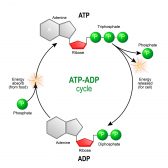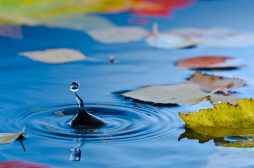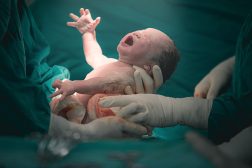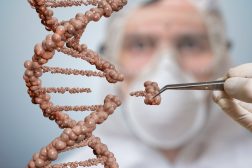Table of Contents
A seaweed refers to any of the macroscopic marine algae. They include the conspicuous, multicellular algal species of Rhodophyta, Phaeophyta, Charophyta, and Chlorophyta. Examples are kelp, Fucus, Ulva, Porphyra, Sargassum, etc.
Etymology
The term seaweed is a combination of the Old English sǣ (“sea”) and Old English wēod (“weed”). It is to refer to any of the weed-like organisms that abound in the seas. A weed is defined as a plant that grows profusely, at any place and time. Thus, its growth is often considered as unwanted or of no value. Seaweeds are, therefore, the weeds in marine habitats because they tend to grow profusely similar to the weeds on land. Synonym: macroalgae.
Characteristics
Seaweeds are multicellular marine plants thriving particularly near the seabed. Thus, they are one of the benthic organisms found near or in marine sedimentary habitats, e.g. along the foreshore and abyssal depths. Some of the fundamental requirements for seaweeds to grow are a seawater habitat, light that can penetrate seabed since it is essential for photosynthesis, and a substrate to attach to. Nevertheless, there are species that are considered as seaweed yet they are freely floating, e.g. Sargassum species.
Seaweeds typically have a thallus body, which is undifferentiated vegetative tissue. They, therefore, do not have true stems, leaves, and roots. A true stem, leaves and roots would have a vascular system as found in higher plants. In spite of this, the macroalgal body resembles most terrestrial plants. The thallus is comprised of the following major parts: (1) lamina, (2) stipe, and (3) holdfast and haptera. The lamina (also called blade) is the leaf-like structure of macroalgae. It is flattened and the shape varies. A stipe is the stem-like structure of the macroalgae. It provides structural support to the thallus. In some species, this part may be absent. The lamina and the stipe are collectively called the frond. A holdfast is the basal part of the thallus. It keeps the macroalga attached to a substrate. Finger-like extensions may be present. They are called haptera. This portion helps the macroalga to anchor to a benthic substrate. Thus, it serves as the root of the macroalgae. A special organ on the blade is called pneumatocyst or air bladder may be present. It helps macroalgae to stay afloat. Another floatation-assisting organ is float. It is located between the lamina and the stipe.
Groups
Multicellular algal species that are considered as seaweeds or macroalgae are those belonging to the following algal groups: red algae, brown algae, and green algae. Not all species though of these algal groups are seaweeds. Unicellular species are also included. Thus, only certain species in each of these groups are regarded as seaweeds.
Ecology
Ecologically, seaweeds are essential ecologically as food source and habitat for marine organisms. Kelps, for instance, serve as a nursery habitat for fishes and other marine species. They are capable of manufacturing their own food by photosynthesis and therefore have a vital contribution to the Earth’s oxygen.
Uses
Humans utilize seaweeds for various purposes such as for medicine, research, food, and fertilizers.
Examples
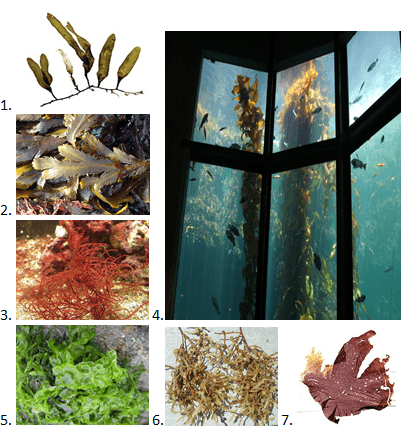
Caulerpa
Caulerpa is a genus belonging to the family Caulerpaceae, order Bryopsidales, class Ulvophyceae, phylum Chlorophyta. Members of this genus are green algae and have a crawling habit. C. prolifera, for instance, is a species that can grow rapidly and form a dense mass on the shallow areas of the sea. The laminae are linked to a chain through an underground stolons (horizontal connections) underneath the sandy substrate as rhizoids keep the stolons in place.
Fucus
Fucus is a genus belonging to the family Fucaceae, order Fucales, class Phaeophyceae, phylum Ochrophyta. Species of this genus are found in the intertidal zones on rocky shores. The thallus is generally subpinnately branched. Pneumatocyts when present are often paired. The thallus is attached to the rock through a holdfast. F. serratus, for instance, has a flattened blade with a distinct midrib and serrated edge of the fronds. It lacks air vesicles.
Gracilaria
Gracilaria is a genus belonging to family Gracilariaceae, order Gracilariales, class Florideophyceae, phylum Rhodophyta. It is a delicacy in Japanese, Hawaiian, and Filipino cuisine.
Kelps
Kelps are brown algae seaweeds from the order Laminariales, class Phaeophyceae, phylum Ochrophyta. The kelp has a thallus that bears flat or leaf-like structures (blades). The root-like structure (holdfast) helps to anchor the kelp to the ocean substrate. Pneumatocysts are also present. They are found at the base of the blades. Examples are Macrosystis pyrifera (giant kelp) and Nereocystis (bullwhip kelp). Kelp forests are areas in marine environment where there is a high density of kelps. They are ecologically significant as they provide a unique habitat for several marine organisms.
Ulva
Ulva is a genus belonging to family Ulvaceae, order Ulvales, class Ulvophyceae, phylum Chlorophyta. Example is U. lactuca that is commonly known as the sea lettuce. It is an edible green alga. It has a thin flat ruffled lamina. It has no stipe but grows attached to rocks or to other algae by its discoid holdfast.
Sargassum
Sargassuma is a genus from family Sargassaceae, order Fucales, class Phaeophyceae, phylum Ochrophyta. Members of this genus are found throughout the world, especially in temperate and tropical oceans. They are typically in shallow waters and coral reefs. They may grow up to several meters. They have berrylike pneumatocyts that help the fronds to float. The thallus often has rough and sticky texture.
Porphyra
Porphyra is a genus from family Bangiaceae, order Bangiales, class Bangiophyceae, phylum Rhodophyta. Members of this genus are found in the intertidal zones in temperate climate. Example is P. purpurea that can be found growing on rock, pebbles, and barnacles. It has a thin reddish blade attached to a substrate by a disk holdfast.(1)
See also
- Algae
- Phycology
- Rhodophyta
- Phaeophyta
- Chlorophyta
References and further readings
- Hardy, F.G. and Guiry, M.D. 2003. A Checklist and Atlas of the Seaweeds of Britain and Ireland. British Psychological Society ISBN 0-9527115-16
- Ecology Of Seaweed And Its Environmental Significance CCBER. (2019). Retrieved from Ucsb.edu website: https://www.ccber.ucsb.edu/collections-botanical-collections-algae/ecology-seaweed-and-its-environmental-significance
- The Seaweed Site. (2019). Retrieved from Seaweed.ie website: http://www.seaweed.ie/qanda/index.php
© Biology Online. Content provided and moderated by Biology Online Editors

